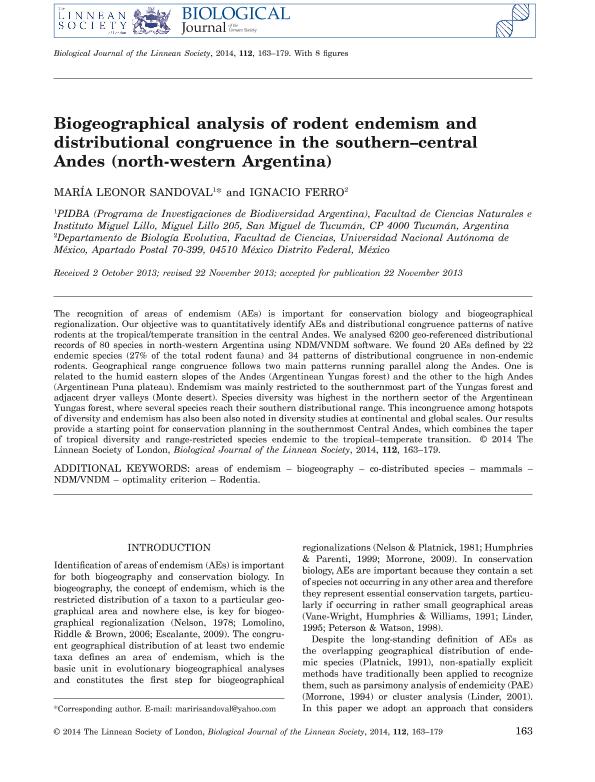Mostrar el registro sencillo del ítem
dc.contributor.author
Sandoval Salinas, Maria Leonor

dc.contributor.author
Ferro, Luis Ignacio

dc.date.available
2017-01-02T17:47:32Z
dc.date.issued
2014-05
dc.identifier.citation
Sandoval Salinas, Maria Leonor; Ferro, Luis Ignacio; Biogeographical analysis of rodent endemism and distributional congruence in the southern-central Andes (north-western Argentina); Wiley; Biological Journal Of The Linnean Society; 112; 1; 5-2014; 163-179
dc.identifier.issn
0024-4066
dc.identifier.uri
http://hdl.handle.net/11336/10683
dc.description.abstract
The recognition of areas of endemism (AEs) is important for conservation biology and biogeographical regionalization. Our objective was to quantitatively identify AEs and distributional congruence patterns of native rodents at the tropical/temperate transition in the central Andes. We analysed 6200 geo-referenced distributional records of 80 species in north-western Argentina using NDM/VNDM software. We found 20 AEs defined by 22 endemic species (27% of the total rodent fauna) and 34 patterns of distributional congruence in non-endemic rodents. Geographical range congruence follows two main patterns running parallel along the Andes. One is related to the humid eastern slopes of the Andes (Argentinean Yungas forest) and the other to the high Andes (Argentinean Puna plateau). Endemism was mainly restricted to the southernmost part of the Yungas forest and adjacent dryer valleys (Monte desert). Species diversity was highest in the northern sector of the Argentinean Yungas forest, where several species reach their southern distributional range. This incongruence among hotspots of diversity and endemism has also been also noted in diversity studies at continental and global scales. Our results provide a starting point for conservation planning in the southernmost Central Andes, which combines the taper of tropical diversity and range-restricted species endemic to the tropical–temperate transition.
dc.format
application/pdf
dc.language.iso
eng
dc.publisher
Wiley

dc.rights
info:eu-repo/semantics/openAccess
dc.rights.uri
https://creativecommons.org/licenses/by-nc-sa/2.5/ar/
dc.subject
Areas of Endemism
dc.subject
Biogeograpgy
dc.subject
Co-Distributed Species
dc.subject
Mammals
dc.subject
Ndm/Vndm
dc.subject
Optimality Criterion
dc.subject
Rodentia
dc.subject.classification
Otras Ciencias Biológicas

dc.subject.classification
Ciencias Biológicas

dc.subject.classification
CIENCIAS NATURALES Y EXACTAS

dc.title
Biogeographical analysis of rodent endemism and distributional congruence in the southern-central Andes (north-western Argentina)
dc.type
info:eu-repo/semantics/article
dc.type
info:ar-repo/semantics/artículo
dc.type
info:eu-repo/semantics/publishedVersion
dc.date.updated
2016-12-28T16:30:39Z
dc.journal.volume
112
dc.journal.number
1
dc.journal.pagination
163-179
dc.journal.pais
Reino Unido

dc.journal.ciudad
Londres
dc.description.fil
Fil: Sandoval Salinas, Maria Leonor. Universidad Nacional de Tucumán. Facultad de Ciencias Naturales E Instituto Miguel Lillo. Programa de Investigación de Biodiversidad Argentina; Argentina. Consejo Nacional de Investigaciones Científicas y Técnicas; Argentina
dc.description.fil
Fil: Ferro, Luis Ignacio. Universidad Nacional Autónoma de México; México. Consejo Nacional de Investigaciones Científicas y Técnicas; Argentina
dc.journal.title
Biological Journal Of The Linnean Society

dc.relation.alternativeid
info:eu-repo/semantics/altIdentifier/url/http://onlinelibrary.wiley.com/doi/10.1111/bij.12233
dc.relation.alternativeid
info:eu-repo/semantics/altIdentifier/doi/http:/dx.doi.org/10.1111/bij.12233
Archivos asociados
